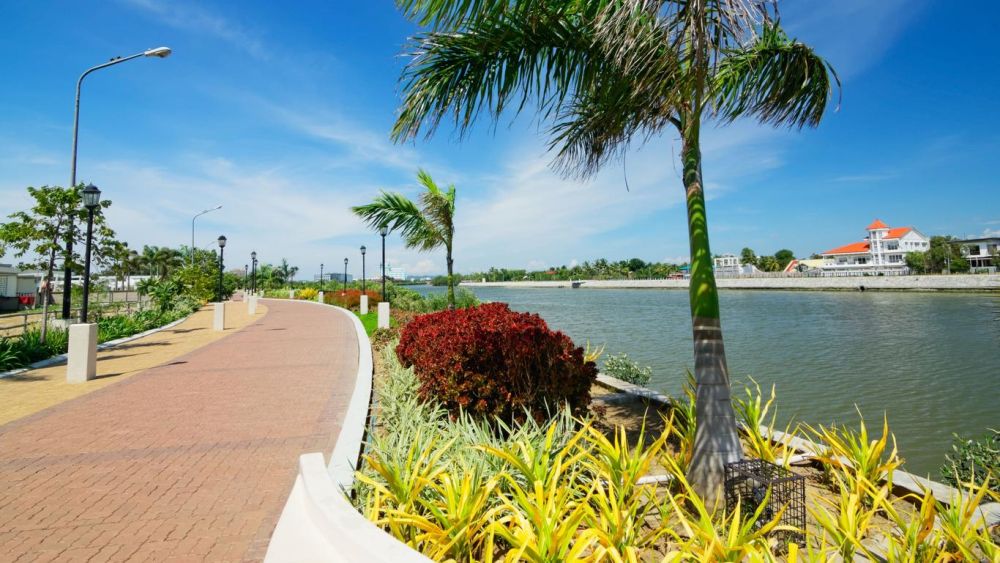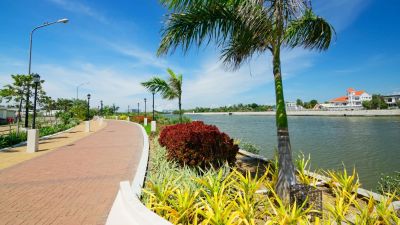

The Iloilo River Esplanade provides a serene environment for both tourists and residents to enjoy a peaceful stroll along a beautifully landscaped pathway. This urban renewal project aims to preserve the natural beauty of the Iloilo River and provide a space for recreational activities such as walking, jogging, and cycling. The Esplanade is adorned with native trees and plants, features various art installations, and offers a view of the gently flowing river. It has benches where one can sit and appreciate the surrounding tranquility or watch the colorful sunset. The Esplanade is also dotted with restaurants where visitors can taste local Ilonggo cuisine. Walking the entire stretch provides an experience of the blend between urban development and ecological preservation, showcasing Iloilo's commitment to sustainability and quality of life.
Celebrated every fourth Sunday of January, the Dinagyang Festival is one of the most vibrant and festive events in the Philippines. Visitors will be treated to colorful parades, energetic dance performances, and cultural showcases. The festival honors the Santo Niño (the Child Jesus) and commemorates the arrival of Malay settlers and the indigenous Ati tribe's conversion to Christianity. The streets come alive with drum beats, chants, and elaborate costumes and headdresses, as various tribes compete in a dance competition. Each performance tells a story, often depicting historical and cultural scenes. For travelers looking to immerse themselves in Filipino culture, the Dinagyang Festival is an event not to be missed. It provides a thrilling spectacle that combines devotion, dance, and the deep-rooted history of the people of Iloilo City.
Garin Farm in San Joaquin, Iloilo, offers visitors an experience that combines agriculture, leisure, and pilgrimage. This unique inland resort has an agricultural theme with a blend of spirituality. Visitors can engage in various farm activities, such undertaking a pilgrimage path that depicts the journey from Creation to Ascension. The walk culminates at the Divine Mercy Cross, which is perched on the highest point of the farm and accessible via a 456-step stairway. At the summit, pilgrims are greeted with a panoramic view of the surrounding landscapes. Additionally, the farm includes recreational facilities and attractions such as swimming pools, fishing areas, and boating. It's an ideal destination for families, faith-based groups, and tourists seeking a contemplative escape amidst nature.
The Jaro Metropolitan Cathedral, also known as the National Shrine of Our Lady of the Candles, is an iconic religious site and historical landmark in Iloilo City. With its impressive Baroque architecture and the revered image of the Nuestra Señora de la Candelaria, it attracts religious patrons and history aficionados alike. It's one of the few churches in the Philippines with a belfry located across the street, adding to its unique charm. Visitors can attend Mass, pray, or simply admire the intricate details of the cathedral's facade and interiors. The Jaro Cathedral is also pivotal during the annual Feast of Nuestra Señora de la Candelaria every February, which includes a procession and various festivities, rendering the cathedral an essential part of Iloilo's rich spiritual and cultural tapest.
The Molo Mansion, also known as Yusay-Consing Mansion, is an ancestral home located in the Molo District that has been transformed into a cultural exhibit venue and souvenir shop. It is a grand structure that showcases the American colonial architecture with evident Chinese influences, highlighting the cross-cultural dynamics of the region. The mansion houses an array of locally made products and Ilonggo art and handicrafts, perfect for tourists looking to take a piece of Iloilo's culture home. The structure itself tells a story of the affluent sugar baron families of the past and now stands as a symbol of preservation of Ilonggo heritage. The mansion's facade makes for a picturesque photo opportunity and is situated near the Molo Plaza and the historical Molo Church—making it a culturally rich site to visit on a tour of Iloilo City.
A UNESCO World Heritage Site, Miagao Church or the Santo Tomas de Villanueva Parish Church stands as a sturdy and stunning example of Baroque architecture. Built in the late 18th century, it features an ornate bas-relief facade and is made from coral and limestone. The church's unique architectural style incorporates Medieval Spanish, Chinese, Muslim, and local influences, which is apparent in its motifs and overall structure. Visitors can admire the detailed artistry on its facade depicting Saint Christopher carrying the Child Jesus, flanked by a coconut tree, papaya, and guava shrubs. The church not only caters to the spiritual needs but is also a testament to the resilience of the Filipino people against numerous challenges throughout history including pirate raids and natural calamities, making it a profound cultural and historical site to explore.
Located in the bustling Mandurriao district, the Iloilo Museum of Contemporary Art is the first museum of its kind in the Visayas and Mindanao regions and is a must-visit for art enthusiasts. ILOMOCA houses several galleries featuring works from both local and international artists, offering a vibrant display of modern and contemporary art pieces including paintings, sculptures, and installations. The exhibitions are well-curated and provide insights into the rich cultural fabric and modern artistic expressions of the Philippines. Art talks, workshops, and other creative events are often held here, making it a dynamic cultural hub in Iloilo. The museum resides within the Iloilo Business Park, which also has a collection of dining, shopping, and lifestyle establishments visitors can explore after their museum tour.
The Gigantes Islands, also known as Islas de Gigantes, offers a breathtaking island-hopping experience in the Visayan Sea. This remote group of islands is a paradise for adventurers and beach lovers, with stunning seascapes, clear turquoise waters, and rich marine life. Visitors can explore pristine white sand beaches, climb to lighthouses for spectacular views, delve into mystical caves, and enjoy fresh seafood. Highlights include the picturesque Cabugao Gamay Island, the Tangke Lagoon—a natural saltwater pool enclosed by towering cliffs, and Antonia Beach's powdery sandbar. Snorkeling and diving enthusiasts will be delighted by sightings of diverse aquatic species around the coral gardens. Gigantes Islands provides the ultimate escape into a tranquil tropical haven.
Camina Balay nga Bato is a colonial-era house that offers a glimpse into the opulent lifestyle of the mestizo families of the 19th century. Guided tours allow visitors to walk through its well-preserved living spaces, adorned with period-appropriate furniture, antique decorative pieces, and religious artefacts. Being inside the house is like stepping back in time to the Spanish colonial period. One of the tour's highlights is the 'tsokolate' experience, where visitors can enjoy traditional Ilonggo hot chocolate made from tablea (cacao tablets) along with local delicacies. As one of Iloilo's historical gems, Camina Balay nga Bato offers an immersive experience in Filipino-Spanish heritage and the rich cultural history of the Iloilo province.
Explore the urban landscape of Iloilo City on two wheels with a guided bike tour. This eco-friendly activity offers a unique perspective of the city's historical sites, bustling markets, and hidden gems. Cyclists will pass through the Iloilo Business Park, Calle Real's restored heritage buildings, Fort San Pedro, and Plaza Libertad among other landmarks. The bike tour not only promotes a healthy lifestyle but also encourages sustainable tourism. Whether you're a seasoned cyclist or a leisure rider, the bike tour is adaptable to different skill levels. It provides an interactive and engaging way to appreciate the city's blend of tradition and progress, with plenty of opportunities to stop for photos, interact with locals, and sample Ilonggo street food along the way.
